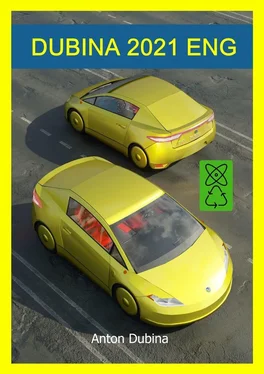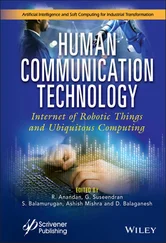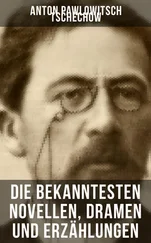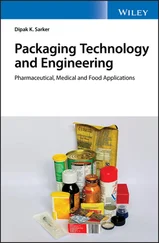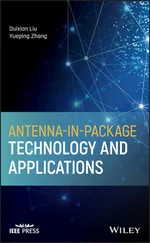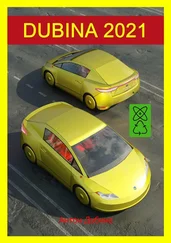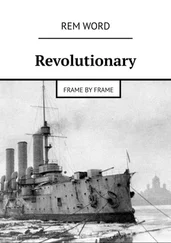DUBINA 2021 ENG
Revolutionary technology
Anton Dubina
© Anton Dubina, 2020
ISBN 978-5-0051-5655-6
Created with Ridero smart publishing system
The most powerful in the universe
“The use of electric transport
the best change in the 21st century”
Anton Dubina
We live in a world of evolving technology. A car is a technical device made up of many parts that change with technology. There are over a billion internal combustion engine vehicles registered in the world today. Toxic substances in exhaust gases cause lung disease and cancer in people living in cities. The design of an electric car does not have large mechanical components such as a starter, carburetor, gearbox. A car with an electric motor accelerates faster. It is in many ways superior to a car with an internal combustion engine. All the wonderful possibilities of the electric drive have not yet been revealed. It will take many years before its properties are fully realized.
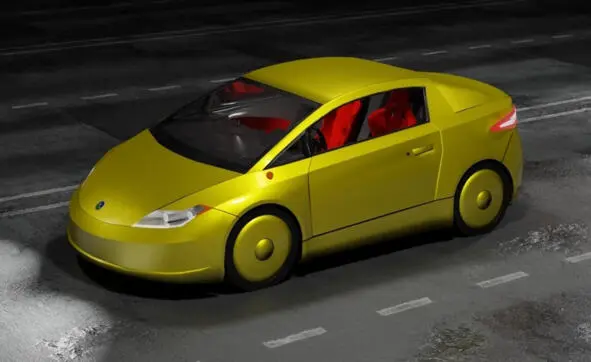
In 2014, I started working on an electric car project. At the time, I was surprised at the lack of electricity-powered cars in cities. People can come home from work and charge the car at night, when the electricity tariff is lower, and go about their business in the morning without wasting time at the gas station. But somehow they don’t. Probably because there are few models of electric cars in the world and their prices are too high. So I made the decision to make a nice and inexpensive electric car.

When designing the DUBINA EVO, I was guided by rules that improve the design. The desire to create the perfect car helped me make the right choice and find the right solution. The distinguishing feature of my sports car is that it combines the best properties with optimized value for money. Car production is carried out with minimal material costs with a fast, streamlined mechanism. The entire production process is carried out in a small factory. To avoid stopping the production process, assembly operations independent of each other. When making a car, we must not forget about ecology. A large number of parts are made from recycled household and industrial waste. Our responsibility is to keep our planet green, the sky blue and the horizon bright. This issue presents my results for 2020. During this year, many technical solutions have been made that have improved the design of the car.
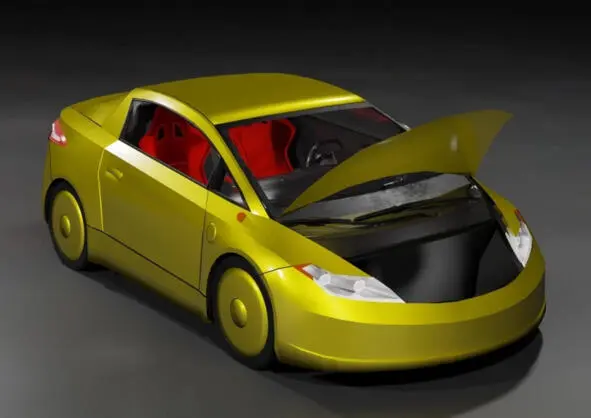
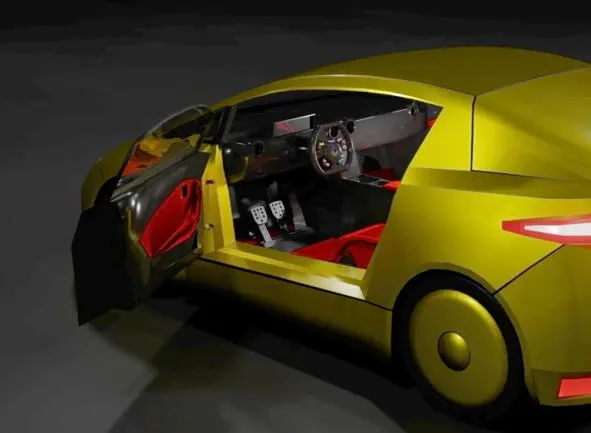
I am interested in your feedback. As a reader of this book, you are the most important critic. Your opinion is valuable to me, and I would like to know what went right, what could be done better, what topics would you like to see and any other wishes you might have. You can send your messages by email.
e-mail: dubina.corporation@gmail.com
website: www.dubina.biz
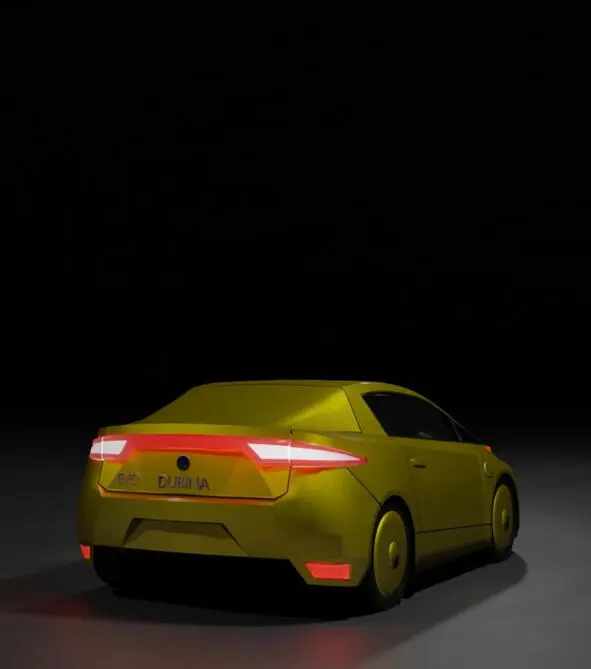
Materialization visualization
The basis of the project activity is software. Design tools are programs that perform various functions. The creation of the DUBINA EVO vehicle information model began with a preliminary design. The sketch was created in the free bitmap graphics editor Krita. It is open source software included with KDE. Krita is developed primarily for artists and photographers and is distributed under the terms of the GNU GPL. The program supports non-destructive editing of layers and masks, work in various color spaces and with various color models – RGB, CMYK, LAB, in the mode from 8 to 32 bits with floating point per channel. In addition, popular filters (such as unsharp masking), adjustment layers, masks and dynamic filters, as well as a series of retouching tools are implemented. However, the main priority of the developers is the realization of opportunities for artists. The concept of the car, its overall dimensions and design features were presented in the draft design. After determining the main dimensions and design features, drawings of the future car were created.
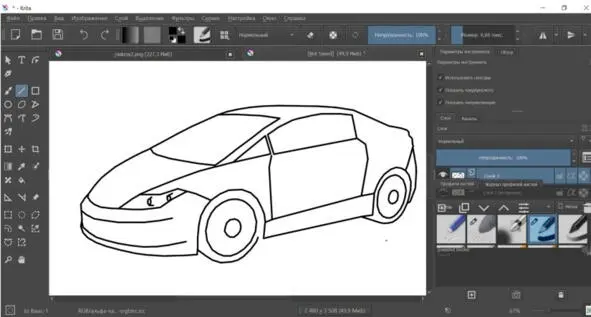
Krita program interface.
Drawings were made in the LibreCAD program. LibreCAD (formerly CADuntu) is a cross-platform, open and free CAD system for 2D drafting and design, built on the basis of QCad. LibreCAD allows you to solve problems of two-dimensional design, such as the preparation of engineering and construction drawings, diagrams and plans. Works under Linux, Windows and Mac OS X operating systems. Distributed under the GNU General Public License version 2. The source code is written in the C ++ programming language using the Qt libraries. Further, a three-dimensional model was built using the drawings. The Blender program is optimal for 3D modeling. Blender is a comprehensive program that combines all the current 3D modeling capabilities. The program is not demanding on the characteristics of the computer, it is possible to carry out design planning, organize an assembly structure and prepare a model for printing on a 3D printer. The use of all basic types of modeling: free forms and sculpting, working with solids (including direct editing), the ability defining parametric dimensions, as well as support for obj and stl formats as imported geometry. All elements that are modeled can be used as further templates for work. The software supports various 3D file formats for import and export, including Alembic, 3D Studio (3DS), Filmbox (FBX), Autodesk (DXF), SVG, STL (for 3D printing), UDIM, USD, VRML, WebM
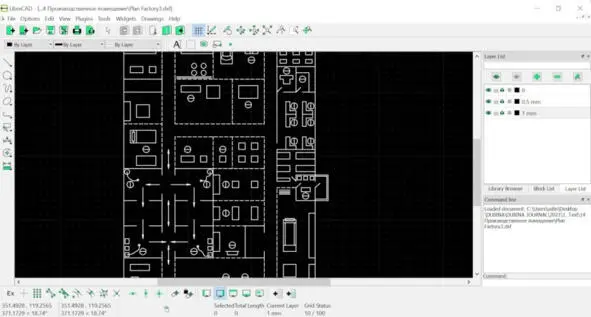
LibreCAD program interface.
Three-dimensional models of car parts were assembled into assembly units and connected to the main parts of the car. The car body was built in sculpting mode. The construction was started by creating one polygon, which was split into 4 equal polygons. Adding one polygon after another gave the body shape. In places requiring more polygons, polygons have been subdivided by the required number. After constructing and editing the longitudinal half of the body, the symmetry modifier was applied. The modifier creates a symmetrical copy of the part. The resulting part changes its shape when the original part changes its shape. By connecting two symmetrical parts of the body, the result is a body when changing, the shape of which on one side changes the shape of the other side. To give the body smooth, smooth lines used three-dimensional patterns. A cylinder was used to build an even circumference of the wheel arches. By applying the cylinder to the wheel arch as a template, the polygon lines were aligned. To draw straight lines on the doors and the threshold of the case, rectangular planes were used. Three-dimensional patterns allow you to check the straightness of polygon lines from all sides. To visually determine the smoothness of the shape of the case, materials with a glossy surface are used. The visual determination of surface smoothness is influenced not only by the type of material, but also by the color.
Читать дальше
